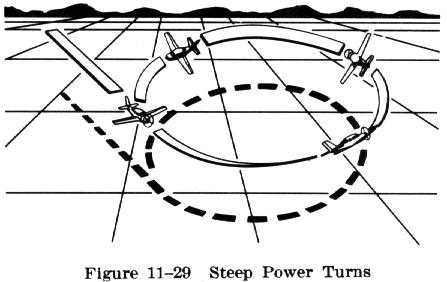
| The "steep power turn" maneuver consists of a turn in either direction, using a bank steep enough to cause an "overbanking" tendency during which maximum turning performance is attained and relatively high load factors are imposed. Because of the high load factors imposed, these turns should be performed at an airspeed which does not exceed the airplane's design maneuvering speed (VA). The principles of an ordinary steep turn apply but as a practice maneuver the steep power turns should be continued until 360 degrees or 720 degrees of turn have been completed, as specified by the instructor or examiner (Fig. 11-29). |
 |
The objective of the maneuver is to develop smoothness, coordination, orientation, division of attention, and control techniques while executing high performance turns.
An airplane's maximum turning performance is its fastest rate of turn and its shortest radius of turn, which change with both airspeed and angle of bank. Each airplane's turning performance is limited by the amount of power its engine is developing, its limit load factor (structural strength), and its aerodynamic characteristics.
The limiting load factor determines the maximum bank which can be maintained without stalling or exceeding the airplane's structural limitations. In most light planes, the maximum bank has been found to be approximately 50 to 60 degrees. The steepest bank possible is that in which altitude can be maintained without the airplane displaying any indication of an approaching stall with all available power.
The pilot should realize the tremendous additional load that is imposed on an airplane as the bank is increased beyond 45 degrees. During a coordinated turn with a 70 degree bank, a load factor of approximately 3 G's is placed on the airplane's structure. Most general aviation type airplanes are stressed for approximately 3.8 G's.
Regardless of the airspeed or the type of airplanes involved, a given angle of bank in a turn during which altitude is maintained, will always produce the same load factor. Pilots must be aware that an additional load factor increases the stalling speed at a significant rate - that is, stalling speed increases with the square root of the load factor. For example, a light plane which stalls at 60 knots in level flight will stall at nearly 85 knots in a 60 degree bank. The pilot's understanding and observance of this fact is an indispensable safety precaution for the performance of all maneuvers requiring turns, particularly near the ground.
Before starting the steep power turn the pilot should ensure that the area is clear of other air traffic since the rate of turn will be quite rapid. After establishing the manufacturer's recommended entry speed or the design maneuvering speed, the airplane should be smoothly rolled into a coordinated steep turn with at least 50 degrees of bank. As the turn is being established, back pressure on the elevator control should be smoothly increased to increase the angle of attack. This provides the additional wing lift required to compensate for the increasing centrifugal force.
After the bank has reached approximately 50 degrees the pilot will find that considerable force is required on the elevator control to hold the airplane in level flight - that is, to maintain altitude. Because of this increase in the force applied to the elevators, the load factor increases rapidly as the bank is increased. Additional back elevator pressure increases the angle of attack which, of course, results in an increase in drag. Consequently, power must be added to maintain the entry altitude and the airspeed.
Eventually, as the bank approaches the airplane's maximum angle, the maximum performance or structural limit is being reached. If this limit is exceeded the airplane will be subjected to excessive structural loads, and will lose altitude, or stall. The limit load factor must not be exceeded, so as to prevent structural damage.
During the turn the pilot should not stare at any one object. To maintain altitude, as well as orientation, requires an awareness of the relative position of the nose, the horizon, the wings, and the amount of turn. The pilot who turns by watching only the nose, will have trouble holding altitude constant; on the other hand, the pilot who watches the nose, the horizon, and the wings, can usually hold altitude within a few feet. If the altitude begins to increase, the bank should be increased by coordinate use of aileron and rudder. If the altitude begins to decrease, the bank should be decreased by coordinated use of aileron and rudder. Rudder should never be used alone to control the altitude.
The rollout from the turn should be timed so that the wings
reach level flight when the airplane is exactly on the heading from which
the maneuver was started. While the recovery is being made, back elevator
pressure must be gradually released and power reduced as necessary to maintain
the altitude and airspeed.